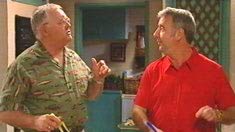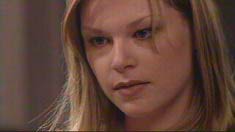|
.
Comment
> Minority Report by
Steve
Following on from my piece on Neighbours’ handling of race, this article will continue this theme to other areas. It has to be said that the show very rarely strays from ‘the norm’ when it comes to creating characters. However, the odd disabled, homosexual and socially unacceptable (though not all three at once) character has occasionally slipped through the net.
 |
Blindness has temporarily affected several characters in Neighbours’ history, but the first legally blind neighbour came in the form of Rohan Kendricks. Although at first he seemed like just another ‘cause of the week’ for Libby Kennedy to preach to everyone about, he soon moved into Ramsay Street, staying at number 22 with Marlene. His storylines became less ‘token’ and more ‘soap’ as he became the obstacle between Libby and Darren getting back together. Other characters, such as Lucy Robinson and Josh Anderson, suffered from temporary blindness, but they always had the miraculous recovery that soaps seem to rely on. Surely having a blind character as a permanent character wouldn’t be that much of a problem. It would probably raise some new and interesting topics for a series that’s been running for twenty years.
Before Rohan, there was Katerina Torelli, a paraplegic with a crush on Mark Gottlieb. Once again, the show had featured characters in wheelchairs before, but Katerina was slightly different. Her disability was only a small part of who she was. The previous year had seen Stephen Gottlieb paralysed after the Waterhole explosion, but after quite an emotional storyline, he was back on his feet in no time and skipping out of Ramsay Street soon after. Katerina’s disability had very little to do with who she was and she certainly wasn’t painted as a very sympathetic character by the time she left, as she attempted to steal Mark Gottlieb away from his girlfriend, Annalise. Unfortunately, by 2003, we were back to the whole ‘paralysed in accident, learns to walk again, takes first steps at party, wheelchair out the window’ plot with Lori Lee. Australian soap producers have often spoken of how they struggle when using wheelchairs in storylines, as they are difficult to move on and off the set during the tight filming schedules. Hopefully, though, next time a wheelchair user is featured, they can at least make their story more like Katerina’s and less like Stephen’s.
Up until 2004, there had been several minor gay characters cropping up in Erinsborough, but they’d never really had a story of their own to tell. The first was Andrew Mackenzie, back in 1994, who was more of a catalyst for Debbie Martin’s bulimia storyline than a character in his own right. After he told Debbie that he was gay, Doug Willis had a few problems socialising with him and he later turned up at the Erinsborough High Debutante Ball with Miss Erinsborough on his arm. That same year, we met Alf Taylor, who returned in 1995 and it seemed was about to ruin his twin brother, Colin’s relationship with Marlene Kratz. Then Alf revealed that he was gay – once again, he was only there to serve as an obstacle in another storyline. 1994 and 1995 were certainly popular years for gay characters, as another one turned up in 1995 in the form of Andrew Watson, a teacher at the school. Andrew’s storyline was definitely a step forward, with a few characters, albeit minor ones, expressing their homophobia. The story saw him being bullied at school, apparently due to his sexuality, and almost deciding to leave, until it was revealed that the bully, Rupert Sprod, was actually doing it because he felt like he’d been victimised. It was definitely an interesting turn of events.
 |
From that point, until 2001, there were rarely any minority characters to speak of and certainly no gay characters. When flamboyant hairdresser Gino Esposito arrived, it wasn’t quite clear what we were dealing with. Mentions of Gino’s “flatmate” Aaron only served to confuse things, but as Gino’s appearances increased, it seemed that he and Aaron were a couple. When Aaron also became a recurring character, working at the garage, the two of them were only seen once on screen together. Gino is the sort of character that is fine in small doses. He certainly embodies every gay stereotype known to man and Neighbours is probably one of the few shows that could get away with having him in the cast. Still, people like him do exist, so why shouldn’t he pop up every now and then. But, like I said, small doses.
 |
As if to counteract Gino, in 2004, Neighbours decided to bring in a new gay character and explore the issue of a teenager coming out. Some viewers were understandably sceptical about this, having survived the show’s sloppy handling of a few other important social issues. However, the series was already looking stronger than it had in several years with well-written, distinctive characters and engaging storylines which didn’t treat viewers like idiots. The arrival of Lana Crawford saw the beginning of a realistic portrayal of a young girl coming to terms with her sexuality. There was no confusion on her part, she just wanted to be open and honest and find somewhere that would accept her as she was. Lana wasn’t just there as a token minority character either, she would appear in as many school scenes as the other young characters and would become involved in their stories as well as telling her own. If nothing else, this story has shown that gay people don’t have to be a separate part of society, whilst also going a step further than the Andrew Watson story in 1995. This time, the issue of homophobia and ignorance was shown properly, with Lana being bullied at school and several parents protesting about the school’s teachings about tolerance.
In conclusion, I think that Neighbours generally has the best of intentions when introducing minority characters into the show. They seem to work best when, like Rohan, Katerina and Lana, they are not simply introduced in order to tell a story about disability or discrimination. These characters were integrated into the community, into storylines that had nothing to do with race, sexuality or disability. Most recently, the character of Lana Crawford has shown that Neighbours is extremely capable of writing a layered, witty, intriguing character, who just happens to be gay, but certainly doesn’t need to preach about it in every scene. Hopefully, we’ll see a lot more storytelling like this in years to come.
Back
|

